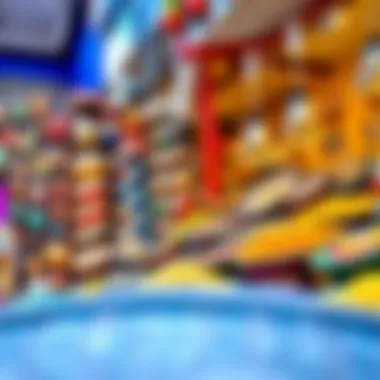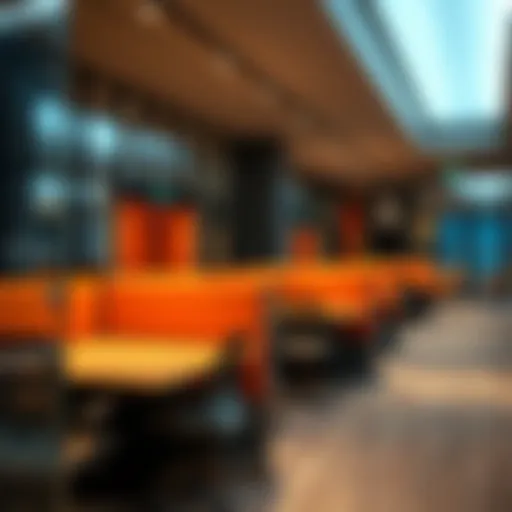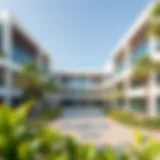Exploring the Naif Market in Deira: A Comprehensive Overview


Intro
Nestled in the heart of Deira, the Naif Market stands as a microcosm of Dubai's rich cultural tapestry. This bustling hub is not just a marketplace but a vibrant reflection of the city's historical significance and contemporary evolution. Strolling through its alleys promises more than just the usual retail experience. The labyrinth of colorful stalls and shops beckons with an array of goods that range from traditional spices to modern gadgets, highlighting the intersection of old and new.
What's remarkable about the Naif Market is its enduring appeal across demographics. Locals mingle with tourists, and shopkeepers, many boasting generations of family history, share tales of the past while embracing the future. This blend of nostalgia and novelty offers a unique lens through which one can view Dubai's socio-economic shifts. The chosen angle of exploration will reveal not just a marketplace, but a pulsating center of commerce, culture, and potential investments.
In the following sections, we dive deeper into the market dynamics, highlighting trends, investment prospects, and the inherent challenges within this lively arena. Each aspect contributes significantly to understanding not only the Naif Market itself but also the broader economic landscape of Dubai.
Market Trends in Dubai Real Estate
Current Market Overview
The real estate landscape in Dubai is a multifaceted entity heavily influenced by various factors including demographics, tourism, and economic policies. The Naif area itself has witnessed a shift as urbanization has intensified. The ongoing regulations in the UAE designed to increase foreign investment reflect a positive sentiment toward real estate. Numerous projects are in the pipeline, aiming to enhance the infrastructure and accessibility of older districts like Deira, placing Naif at the forefront.
The buzz around upcoming developments adds a layer of anticipation for investors looking at potential returns. Market data indicates that while global economic uncertainties linger, Dubai's real estate sector remains relatively resilient. More specifically, the focus is shifting towards integrating culture and commerce in traditional markets, which affects property dynamics significantly.
Price Trends and Forecasts
As we navigate through the metrics of property pricing, the Naif region presents a mix of opportunities. Average price per square meter fluctuates, influenced by proximity to key attractions and commercial viability.
Key observations include:
- Affordability: Prices tend to be comparatively lower than those in more upscale areas like Dubai Marina or Downtown.
- Growth Potential: Given the government's commitment to revitalizing Deira, property values are likely to show upward momentum in the coming years.
- Rental Demand: An influx of expatriates and tourists in search of authentic experiences keeps the rental market robust, allowing for decent rental yields.
Investors should keep a close eye on upcoming redevelopment initiatives, as these will heavily impact future pricing and opportunity within this historic marketplace.
Investment Opportunities
Hot Areas for Investment
For investors eyeing the Naif Market, certain segments stand out, providing promising avenues for growth:
- Retail Spaces: With a surge in consumer interest towards local handicrafts and authentic products, the demand for retail spots is rising.
- Mixed-Use Developments: Incorporating residential, commercial, and cultural spaces can maximize returns.
- Tourism Initiatives: Investing in properties catering to the influx of tourists could boost profitability, especially with many seeking to explore Dubai's cultural heritage.
Rental Yield Analysis
The allure of the Naif Market isn't just its immediacy of consumer traffic but also its rental yield potential. An analysis of rental yields reveals:
- Diversified Options: From short-term holiday rentals to longer-term residential leases, opportunities abound.
- Seasonal Fluctuations: Yields may vary significantly based on tourist seasons, thus necessitating strategic planning by property owners.
- Projected Returns: Given the area's current real estate trajectory, investors can anticipate competitive rental yields as the market continues to mature.
With strategic maneuvers and foresight, engaging with Naif Market can prove not only viable but indeed lucrative for those inclined to explore deeper into Dubai’s engaging real estate opportunities.
"The Naif Market is a living testament to the evolving narrative of Dubai, marrying history with modernity—it's a goldmine waiting to be tapped."
For detailed resources and comprehensive analyses, refer to platforms like Wikipedia and Britannica, where economic insights are meticulously cataloged. Additionally, engaging with community-driven insights on Reddit, or exploring property dynamics through local forums and real estate agencies can amplify understanding of this buzzing marketplace.
Prelude to the Naif Market
The Naif Market, nestled in the bustling enclave of Deira, is far more than just a shopping destination. For investors and real estate agents eyeing potential opportunities in Dubai, understanding this marketplace offers a glimpse into the cultural and economic heartbeat of the city. The importance of diving into its past, present, and significance can’t be overstated; it unlocks the secrets of consumer behavior and market dynamics in one of the world's fastest-growing economies.
History of the Naif Market
As the sun cast its first light on Dubai's history, the Naif Market emerged as a central hub for trade and culture. This market's roots date back to the late 19th century when it served as a primary location for merchants selling essential goods. As Dubai blossomed into a bustling metropolis, the Naif Market preserved its character while adapting to the tides of change.
Once a quaint gathering space, it grew into a vibrant tapestry of threads, colors, and fragrances, each stall telling a tale of its own. From textiles imported from the Levant to spices hailing from the Indian subcontinent, the market became a melting pot of cultures. Local legends hint at how the market is named after a historical fort, which was once a defensive structure, indicating the area’s long-standing significance.
The development of the area saw some ups and downs; however, its resilience ensures it remains a focal point today. The very stones of the Naif Market resonate with the whispers of traders from decades past, where neighbors gathered not just for business, but to share stories and partake in community life.


Cultural Context and Significance
The Naif Market stands as a testament to Dubai's rich cultural heritage. It serves as a current-day manifestation of the city's historical trade routes and social interactions. The market embodies the spirit of a community that, for generations, has woven together diverse cultures and traditions.
From the moment you step into the market, you're engulfed by the sensory experiences it offers: the vibrancy of textiles, the tantalizing aroma of spices, and the intricate craftsmanship of traditional artifacts. Each corner of the market reveals nuances of Emirati culture, showcasing not just commodities but also the stories entwined with their creation.
For investors, understanding this cultural fabric is crucial. The market is more than a place for transactions; it's where community bonds strengthen. As newer businesses pop up, blending with the old, it becomes apparent that leveraging this cultural significance can create robust marketing strategies, nurturing consumer loyalty like no other.
In essence, the Naif Market is not merely about trading goods. It reflects a rich cultural narrative, offering insights into consumer patterns that can steer investment strategies. Ignoring this aspect could mean missing out on the pulse of the thriving market landscape in Dubai.
Geographical Location and Accessibility
Understanding the geographical location and accessibility of the Naif Market is quite important. It not only shapes the experience of visitors and shoppers, but also has profound implications for local business owners looking to attract a diverse clientele. Positioned in the heart of Deira, nestled among busy streets and vibrant neighborhoods, the market serves as a vital artery for economic activity. The easy access to both local and international transport systems enhances its attractiveness to consumers and vendors alike.
Proximity to Key Urban Areas
The Naif Market is within a stone's throw from several key urban areas, making it an appealing destination for both locals and tourists. Situated just a short distance away from significant locations like Dubai Creek and the famous Gold Souk, its proximity ensures a constant flow of foot traffic.
Being close to the urban centers offers several advantages:
- Attracts Diverse Customers: The market becomes a melting pot of cultures as shoppers from different backgrounds converge.
- Convenience for Locals: Easy access means that residents can shop regularly for their daily needs without much hassle.
- Increased Visibility for Businesses: Vendors located here enjoy a competitive edge because the location draws significant attention.
Moreover, guiding travelers from nearby hotels and attractions ensures that even those who are less familiar with Dubai can find their way. Spending a few moments in this marketplace can enrich their understanding of the city’s vibrant culture.
Transport Links and Infrastructure
Access to the Naif Market is streamlined by well-developed transport links and infrastructure. The proximity to the Dubai metro, particularly the Al Rigga and Union stations, is a game-changer. These stations provide efficient and cost-effective transport options to and from various parts of the city.
In addition, several bus routes run through nearby areas, ensuring that public transport is both comprehensive and user-friendly. For those who prefer personal travel, the availability of parking spaces around the market area is a boon.
Some notable transportation features include:
- Metro Connectivity: Speedy connections facilitate quick access to various neighborhoods and landmarks.
- Taxis and Ride-Hailing Services: Easily available, these services cater to those preferring a more direct route.
- Walkable Areas: The streets surrounding the market are pedestrian-friendly, encouraging shoppers to explore not just the market, but also nearby attractions.
The synergy of location and transport accessibility enhances the market's economic prospects, positioning it as a favourable site for vendors and consumers alike.
Overall, the strategic location along with excellent transport links makes Naif Market a hub that is hard to overlook. Potential investors and business owners seeking to tap into Dubai's lucrative market should carefully consider these geographic and infrastructural advantages.
Market Composition and Offerings
Understanding the market composition and offerings of the Naif Market is crucial for grasping its allure for both buyers and investors. The Naif Market is not just a trading post; it's a vibrant mélange of history and modernity, embodying the spirit of Dubai. From traditional crafts to the latest electronics, the mix of goods available reflects the cultural diversity of the area and attracts a wide array of consumers.
The offerings range across various categories, each drawing a different crowd based on preferences, needs, and socio-economic backgrounds. This article delves deeper into the segments available in the market, emphasizing the distinct characteristics and appeal of each. This approach not only paints a clearer picture for potential investors but also equips consumers with insights to navigate the market efficiently.
Categories of Goods Available
Textiles and Clothing
When one walks through the vibrant alleys of Naif Market, the textiles and clothing section can hardly be missed. Known for its colorful displays and rich textures, this area draws both locals and tourists alike. The fabrics here are handpicked for their quality and uniqueness, often sourced from local artisans. What sets this clothing apart is the fusion of traditional designs with contemporary trends. This blend not only resonates with a modern audience but also preserves cultural heritage.
Textiles from the Naif Market are often sought after for their affordability compared to high-end stores in Dubai. Shoppers can snag a stylish outfit or a vibrant scarf without breaking the bank. However, it is worth noting that while the price is appealing, the durability and longevity of the clothing can vary. Thus, it's advisable for consumers to be discerning and check for quality.
Traditional Artifacts
Another gem in Naif Market is its traditional artifacts section, a treasure trove for anyone seeking a piece of Dubai's rich history. Here, shoppers can find everything from intricate gold jewelry to traditional daggers, known as khanjars. The key characteristic of these items is their craftsmanship—many are handmade, preserving centuries of artistry. This not only appeals to collectors but also to tourists looking for authentic souvenirs.
The unique feature of this section is that purchasing an artifact is often synonymous with owning a piece of cultural narrative. However, one must be aware that the prices can fluctuate based on authenticity and craftsmanship. Collectors should ensure proper verification when investing in these artifacts.
Electronics and Gadgets


In recent years, the electronics and gadgets segment of Naif Market has seen substantial growth. It’s a bustling area filled with shops that offer latest smartphones, accessories, and home gadgets. The competition in this niche is fierce, pushing sellers to offer competitive prices and frequent deals. Buyers often venture here for the latest tech at a fraction of the cost found in larger retail chains.
What's particularly notable is the availability of both regional and international brands, catering to a diverse clientele. Shoppers appreciate the chance to physically play with gadgets before buying, an experience often lost in online shopping. However, it’s critical to exercise caution as deals can sometimes be too good to be true. Buyers should be vigilant about warranty terms and product authenticity.
Emergence of Modern Retail
As consumer habits shift, Naif Market has observed an emergence of modern retail. While it holds onto its traditional roots, there's a noticeable integration of contemporary retail practices that enhance the shopping experience. This evolution helps in maintaining relevance amidst the growth of global brands in Dubai.
Modern retail spaces, with structured layouts and streamlined checkout processes, attract busy consumers who appreciate convenience without sacrificing cultural appeal. This hybrid approach of blending modernity with tradition makes Naif Market a hotspot not only for shopping but also for experiencing Dubai’s dynamic socio-economic landscape.
The future holds promise for Naif Market as it navigates the challenges posed by changing consumer preferences. Continued growth in both the traditional and modern retail sectors will likely provide new opportunities for stakeholders, from investors to shoppers alike.
Economic Impact of the Naif Market
The Naif Market, often dubbed as the beating heart of Deira's old-world charm, does more than just cater to local shoppers; it plays a pivotal role in the economic framework of Dubai. This market is a dynamic space where traditional commerce meets the modern world, fostering an ecosystem ripe for economic growth. Within its bustling corridors, visitors won't only discover unique goods but also witness how a local market can buoy the larger economy.
Contribution to Local Economy
At the core of Naif Market's influence is its substantial contribution to the local economy. This market provides a vital source of employment, directly and indirectly supporting various sectors. Many families rely on the livelihood generated from their stalls, selling everything from spices to clothing.
- Job Creation: The market employs numerous shopkeepers, vendors, and service providers, thus elevating the standard of living for many residents.
- Local Suppliers: Many vendors source their products locally, which not only helps local artisans but also keeps money circulating within the community.
- Economic Diversification: It's a rather unassuming fact that the market showcases the efforts to diversify Dubai's economy beyond oil dependency.
This grassroots economy fuels further development projects in the area, encouraging both public and private investment. As businesses flourish, reinvestment becomes the name of the game, leading to an increasingly vibrant market atmosphere.
Role in Dubai's Tourism Sector
Naif Market is not just a local shopping hub; it serves as a key player in Dubai's tourism landscape. Many tourists flock to this market looking for authentic experiences that larger malls cannot provide.
- Cultural Experience: Tourists are often drawn to Dubai's rich heritage, and Naif Market, with its spice shops and traditional artifacts, offers a glimpse into the local culture that modern establishments cannot replicate.
- Aesthetic Appeal: The vivid colors and scents of the market create a sensory overload that attracts visitors, compelling them to capture moments to share on social platforms like Instagram. This organic publicity benefits the market immensely.
- Value for Money: International visitors often find items in Naif Market to be more competitively priced than in larger retail venues, creating a win-win situation for both shopkeepers and consumers.
"Naif Market combines tradition and tourism in a manner that fuels the local economy and enhances Dubai's cultural tapestry."
Overall, the Naif Market not only supports daily essential needs for the community but also enhances the tourism experience, ensuring that both locals and visitors alike leave with a sense of connection to Dubai's rich heritage. The interplay between the market and the economy showcases a compelling model for other regions, especially in burgeoning cities aiming for a blend of the traditional and modern.
Consumer Demographics and Behavior
Understanding the consumer demographics and behavior at Naif Market is crucial for various stakeholders, including investors, shop owners, and urban planners. With its rich history and diverse product offerings, knowing who frequents the market can drive business strategy and community engagement. By analyzing buying habits, preferences, and demographic data, businesses can tailor their marketing efforts to meet the demands of their audience more effectively, ultimately leading to increased profitability and sustainability.
Target Audience Insights
The Naif Market attracts a varied group of consumers, including local residents, expatriates, and tourists. Each segment brings unique preferences and expectations, making it important to grasp their characteristics:
- Residents: Many of the local shoppers value the affordability and variety of goods. They often seek traditional items, such as textiles, spices, and other household needs. This segment tends to have a good understanding of the market's nuances, often returning for favorite shops. They might even barter for prices, as it's a common practice in such markets.
- Expatriates: This group usually seeks novelty and authenticity. They might come to Naif for a taste of local culture or to find gifts for family back home. Their buying behavior leans toward traditional crafts and souvenirs, which are readily available at the market.
- Tourists: Visitors typically gravitate toward the vibrant atmosphere of Naif Market. They are often captured by the allure of bargaining and the colorful displays of merchandise. The items they purchase can range from electronics to handcrafted items, all while seeking an experience that embodies Dubai's cultural richness.
Considering these segments helps tailor marketing strategies and product offerings. For instance, employing bilingual staff can enhance the shopping experience for diverse visitors, while promoting local products can draw in residents eager for authentic goods.
Shopping Preferences and Trends
In terms of shopping behavior, several trends prevail among consumers at Naif Market:
- Budget-Conscious Buying: Many shoppers are keen on finding bargains without compromising quality. The presence of both high-end and low-cost products helps to cater to this need. This dual pricing strategy can attract a wider consumer base.
- Increasing Demand for Online Shopping: With the digital age, some traditional shoppers are displaying a growing preference for online avenues. However, many still cherish the in-person experience of navigating the market and engaging with vendors directly.
- Community-Centric Purchases: Items that promote community culture and heritage, such as spices and handicrafts, are becoming increasingly popular. Consumers are drawn to products that tell stories and represent local artisanship.
In identifying these trends, business owners can think about optimizing their offerings and marketing strategies. For instance, they might consider enhancing the shopping experience by adding online catalogs, or incorporating community-focused events that spotlight local artisans.
These factors contribute greatly to shaping a sustainable market environment and enhancing consumer loyalty.
All in all, understanding the demographic landscape and shopping behavior of Naif Market not only aids in addressing consumer needs but also empowers stakeholders to navigate market challenges more effectively. The fluctuations in trends push businesses to stay ahead of the curve, fostering resilience in a competitive landscape.


Challenges Facing the Naif Market
The Naif Market, while vibrant and historically rich, is not without its hurdles. Understanding these challenges is critical for stakeholders looking to invest or engage in this unique marketplace. The market is navigating several complex issues that affect its future viability and attractiveness to consumers and entrepreneurs alike.
Competition with Modern Retail
The rise of modern retail spaces in Dubai poses a significant threat to the traditional charm of the Naif Market. As sleek shopping malls and global brands take center stage, local markets face an uphill battle. Consumers often gravitate towards the convenience and experience that contemporary shopping environments offer. The bright lights, air-conditioned spaces, and curated brand experiences stand in stark contrast to the crowded stalls of Naif. While foot traffic remains strong, the market must adapt to a changing retail landscape.
Some factors contributing to this competitive environment include:
- Brand Recognition: Established brands have a knack for capturing consumer loyalty. The familiarity of names like Carrefour or Mall of the Emirates draws shoppers away from bustling souks.
- Infrastructure: Modern retail spaces offer amenities that enhance shopping experiences. Clean facilities, ample parking, and easy accessibility make them more appealing to consumers.
- Marketing Strategies: Big players invest heavily in marketing and promotions to lure crowds, something traditional markets struggle to match.
There’s an increasing need for Naif Market to highlight its unique selling propositions—authenticity, diversity, and affordability—while innovating on customer experience. Without proactive adjustments, it risks losing its appeal to the next generation of shoppers who may not feel the same connection to traditional markets.
Regulatory and Operational Challenges
Another area of concern for the Naif Market is the regulatory framework that governs its operations. Local and regional policies can impact how businesses in the market function. Regulatory compliance can lead to increased costs and operational delays, affecting many vendors. For instance:
- Licensing: Obtaining business licenses in Dubai can be convoluted, with varying requirements for different goods and services. Vendors often spend valuable time and resources navigating this minefield, which could have been dedicated to growing their businesses.
- Health and Safety Regulations: As with any marketplace, especially one dealing in food and consumer goods, strict adherence to health codes is non-negotiable. Financial implications of non-compliance can weigh heavily on small traders.
- Operational Restrictions: City regulations can impose restrictions on trading hours or the types of goods that can be sold, limiting the market’s ability to pivot or capitalize on emerging trends.
The Naif Market represents a dynamic confluence of culture and commerce, yet it must navigate a complex web of challenges to remain a viable retail destination in Dubai’s ever-evolving landscape.
The intersection of competition with modern retail and regulatory hurdles symbolizes just a portion of the issues facing the Naif Market. Stakeholders, from investors to local shop owners, must remain vigilant and adaptable to forge a path forward. Without recognizing and addressing these challenges, the market may face gradual decline amid the allure of its more polished counterparts.
Future Prospects for the Naif Market
The future prospects for the Naif Market are critical in understanding its potential impact on both local and tourist economies. Given the rapid changes in consumer behavior and the rise of modern retail, the market must adapt to thrive. The current landscape of retail is evolving, so identifying opportunities for growth is essential. Investors, homebuyers, and real estate agents stand to gain insights into market dynamics that could shape future developments within this vibrant hub.
Potential for Growth and Development
Growth opportunities abound within the Naif Market. Firstly, the increase in tourism, especially with Dubai's position as a global travel nexus, presents numerous avenues for expansion. The unique blend of cultural heritage and modern amenities makes Naif Market appealing to both tourists and locals.
- Diversification of Offerings: As consumer preferences shift, introducing new categories like organic products, artisanal crafts, and eco-friendly goods can attract a broader audience.
- Integration of Technology: Embracing e-commerce and mobile payment options can enhance the shopping experience. Offering online services allows accessibility to a wider customer base, especially during off-peak seasons.
- Event Hosting and Promotions: Special events, such as cultural festivals or seasonal sales, can draw crowds. These activities not only showcase local talent but also engage the community and boost foot traffic.
Moreover, urban development surrounding Naif Market could contribute to increased footfall, thus broadening its market base. Improving transportation links would further encourage local shoppers to frequent the area.
Strategic Initiatives for Improvement
To ensure the sustainability of the Naif Market, several strategic initiatives must be considered. The focus should not only be on physical improvements but also on enhancing the overall market atmosphere and shopping experience.
- Collaboration with Local Artisans: By partnering with local artists and craftsmen, the market can showcase unique products while supporting the community.
- Revamping Infrastructure: Upgrading facilities, like rest areas and signage, can improve visitor experience. Aesthetic improvements coupled with functional enhancements (such as more clearly defined pathways) could make navigation easier.
- Educational Programs: Workshops on local crafts, cooking classes, or cultural presentations can attract diverse demographics. These programs not only increase engagement but also foster learning about local traditions and products.
In closing, the Naif Market's future hinges on its ability to balance tradition with modern retail trends. By pursuing innovative growth strategies and responding to consumer needs, it can solidify its status as a vital marketplace in Deira, benefiting all stakeholders involved.
Finale
The conclusion of this article encapsulates the myriad elements that underscore the significance of the Naif Market in Deira, Dubai. This market is not merely a place where goods are exchanged; it is a thriving hub steeped in rich history, cultural nuance, and economic vitality. The importance of examining such a vibrant locale lies in understanding its role as a microcosm of Dubai's broader socio-economic dynamics.
One of the critical elements discussed throughout the article is the market's ability to adapt to the changing tides of consumer preferences. Through the lens of traditional offerings and modern retail experiences, the Naif Market reflects the evolution of shopping habits, which continue to shape urban commerce in the region. Moreover, by analyzing the economic impact of the market, particularly its contributions to local livelihoods and tourism, stakeholders can appreciate the direct link between the health of this market and the overall economic well-being of Deira.
Furthermore, challenges faced by the Naif Market, such as competition from modern retail and regulatory hurdles, emphasize the need for strategic planning and innovation. The discussions around potential growth and strategic initiatives for improvement provide a roadmap for current and prospective investors looking to delve into this market. Thus, the conclusion draws attention to the broader implications for stakeholders, setting the stage for a more nuanced understanding of what the future could entail for the Naif Market.
Summary of Key Points
In summarizing the key elements presented in the article, we find several noteworthy highlights:
- Historical Significance: The Naif Market is a testament to Dubai's rich past and cultural identity.
- Cultural Relevance: It acts as a vibrant space where diverse communities converge, making for a lively and multifaceted shopping experience.
- Economic Contributions: The market plays a pivotal role in bolstering the local economy and attracting tourism.
- Consumer Behavior Trends: Insights into consumer demographics showcase changing shopping preferences, reflecting both heritage and modernity.
- Future Prospects: Identifying growth opportunities allows for strategic positioning that could elevate the market's profile further.
Implications for Stakeholders
The implications of the findings from this exploration extend to various stakeholders:
- Investors: The Naif Market presents genuine opportunities for investment, especially as they navigate on the cusp of transformation in cultural retailing.
- Homebuyers and Real Estate Agents: As Deira continues to evolve, understanding the market's dynamics can inform real estate decisions, leading to more strategic acquisitions or developments in the area.
- Local Businesses: For small retailers and artisans, recognizing trends and adapting to consumer demand ensures survival and growth in a competitive landscape.
Understanding the Naif Market's complexities can better equip these stakeholders to engage with the local economy effectively and leverage the opportunities it presents.















